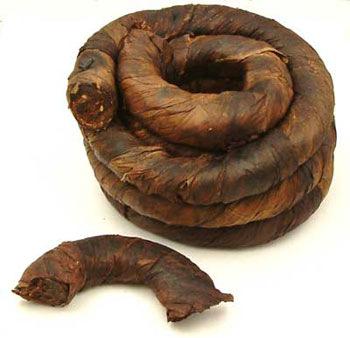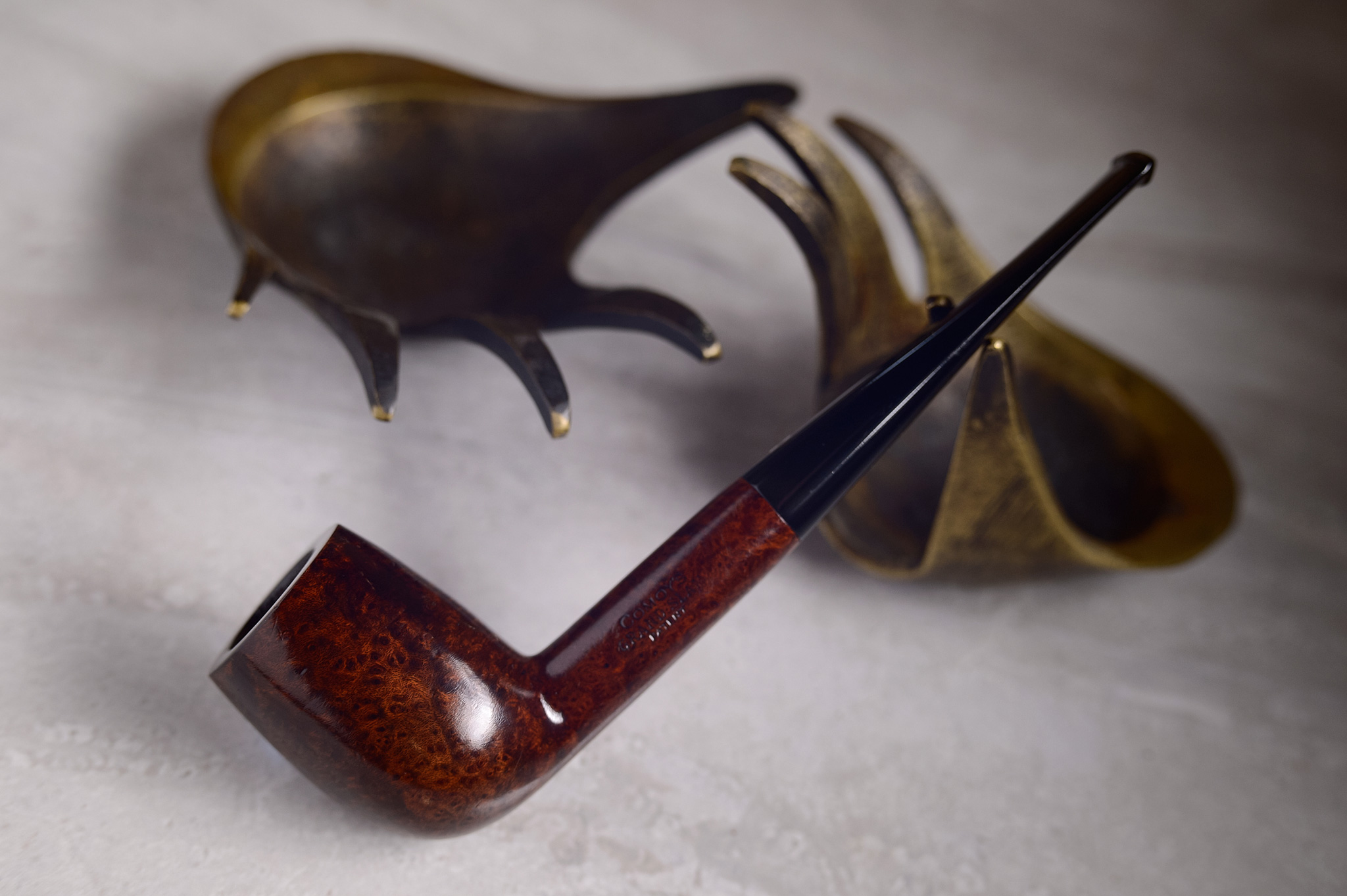By G. L. Pease
 Welcome to our third monthly installment of Ask G. L. Pease.
Welcome to our third monthly installment of Ask G. L. Pease.
Rick poses a good question about consistency: I have a question about tobacco supply and how blends change. C&D has been providing tobacco and manufacturing your blends for at least a decade, right? What tobacco stock (if any) of virginia, orientals, latakia, burley or cavendish (do you even use cavendish?) used to make those earliest blends is still around? And assuming some of those stocks have been replaced, how do you adapt old blends to new tobacco stocks? Do you choose to move to a new supply, even if the original supply is still around? Thanks!
A: It’s a great question, Rick. Interestingly, between the time that you sent it in.”, and the time that I pulled it out of my hat for inclusion here, I wrote an article addressing some aspects of this very subject. You can read more in The Hobgoblins of Consistency right here in my Out of the Ashes column. I think you’ll find it interesting, and possibly even a bit surprising.
From Phil in Switzerland: Congrats to your fantastic New World Collection, I immensely enjoy both of them. My question is: Which one of your tobaccos would you consider best applicable for aging? And which one is your own favorite of your tobaccos?

A: Thanks, Phil. I’m really excited about the New World Collection too. It’s been quite a departure for me, a lot of fun, and I couldn’t be happier with either the results or the response. I’ve got some ideas for future things, too. Aging? All of them, really. I’ve always appreciated well-aged blends, so I’ve kept an eye towards both short- and long-term aging when designing my tobaccos.
As for my faves, I suppose I could just be glib and say that it’s whatever I’m smoking when someone asks the question. I don’t really have a favorite, but there are a few blends that find their way into my pipes more often than others. During the summer, I love Key Largo and Chelsea Morning quite a lot. In the cooler months, I tend towards fuller mixtures and flakes. Meridian has gotten a lot of my attention since I released it, and I have a feeling my new Lagonda will burn up around here at a rapid rate.
Plugless: I keep seeing things about flakes, cakes, crumble cakes, broken flakes, plugs, ropes – what the hell is the difference between all these cuts? O great guru of all things tobacco, please answer my question so I can finally sleep again at night. -Plugless in Seattle
 A: Since you’re Plugless in Seattle, and since it’s a natural place to start, let’s look at plugs, and go from there.
A: Since you’re Plugless in Seattle, and since it’s a natural place to start, let’s look at plugs, and go from there.
Tobacco strips, which are mostly whole leaves with the midrib removed, are layered into a box-like form, a mold about 15" square, in specific proportions, then pressed under several tons per square inch of pressure for several days. What emerges from this process is a large, hard block of tobacco, which is cut into small bars, plugs or cakes that resemble chocolate brownies.
Cakes are dense, and hold their moisture well, so are therefore convenient to carry. But, they require preparation before they can be smoked. The smoker slices off a bit, to the desired thickness, and rubs it between the palms to create a ribbon, fine or coarse, according to preference. It can also be cut into thicker slices, then cross-cut twice to make a rough cube-cut. It’s a very versatile form.
If the bars are sliced thin at the factory, the result is what’s commonly referred to as flake, which can be rubbed-out for smoking, or folded and rolled, and so on. Broken flakes are just flake-form tobacco that’s been partially broken up, rather than left in its rectangular form.
 |
 |
Ready-rubbed is flake tobacco that’s been mechanically rubbed out into thick ribbons, similar to the mixtures in my own Old London Series.
Crumble cake is a little different, in that rather than strips, the cakes are made from ribbon-cut tobaccos. The smoker can easily break off a chunk, crumble it between the fingers, and make it ready for smoking. This form shares the moisture-holding capacity of plugs, with the added convenience of being somewhat easier to prepare. The downside to this form is that it tends to break into small fragments, which can clog the airway or burn quickly. Still, for many, it’s a worthwhile trade-off.
 Ropes or lanyards are exactly what they sound like. The tobacco is spun by machine into long ropes, which are cut to length for sale. There are a few spun-cut tobaccos in which these ropes are cut into coins for final packaging.
Ropes or lanyards are exactly what they sound like. The tobacco is spun by machine into long ropes, which are cut to length for sale. There are a few spun-cut tobaccos in which these ropes are cut into coins for final packaging.
Each of these forms has a strong following. It’s worth exploring all of them, just to see what they’re like. It’s never too late to try new things! And, if you do, you might be Plugless no more.
David’s question: In the connoisseur’s tobacco tasting lexicon, the term "body" seems maddeningly elusive. Carl Ehwa called it a "feeling" of aggression on the palate, distinguishing it from intensity of flavor. Fred Hanna spoke of body as "largeness, intensity, or power of taste", and so did Russ Ouellette. Their definitions of body and Ehwa’s are thus nearly opposite. Elsewhere I have seen "body" used pretty much as a synonym for strength, or even just for density of smoke – striking the term further with the curse of Babel. The equivocations have got me confused. What is body, exactly? If it is licit to add a P.S.: is there any chance that you would consider writing a Tobacco Tasting book analogous to the great Wine and Scotch tasting books out there; a niche we desperately need filled, and which I think you would be just the man to write?
A: Some terms, like "body," seem to be steeped in disagreement amongst knowledgeable pipemen, and are really hard to pin down. (If you want to cause the pipe smoker’s equivalent to a riot, which is just a bunch of guys raising their eyebrows and temporarily engaging in a paroxysm of heavy puffing, ask about rhodesians vs. bent bulldogs.) I generally think of "body" as something outside of the spectrum of taste, and probably would find myself aligning more closely with Ehwa’s definition, if I truly understood what he was on about. Body is the mouth-feel, the weight of the smoke on the palate. It’s what’s different between light, gassy smokes and heavier, fuller ones. It’s not a measure of strength, though stronger tobaccos tend to offer a fuller bodied smoke than milder ones, but more a measure of presence, if that makes any sense. Blends with a lot of body can seem almost oily on the palate, or have a longer, more lingering finish.
Betty wants to know: About 25 years ago, Peterson’s ( not related to the company in Ireland) had three stores in New York and a mail order house in New Jersey. They had a bulk blend called Peterson’s 600. It was a rough cut all natural tobacco with Virginia butterfly and other great tasting tobacco. They left the scene and I have not been able to find this blend anywhere. I contacted Perterson’s in Ireland and they told me that they never had a store in New York nor do they sell bulk tobacco. Can you help me?
A: Betty, I really wish I could, but I have no knowledge of the tobacco you refer to. Now that it’s out there in the big wide world of our wonderful and knowledgeable readership, maybe someone will be able to offer some assistance. If anyone can answer Betty’s question, please use the comment form below. We’d all love to know!
Q: Pieter writes: "I have the idea that a pipe with a long shank – lovat and canadian – delivers more flavour? I have Savinelli and Stanwell canadians and a Davidoff lovat. My new Stanwell also sports quite a long shank, almost like a lovat. It seems as if these pipes smoke a bit cooler and also bring out more of the tobacco’s flavour. Can it only be my imagination because I love this kind of pipe?"

A: Pipes are fascinating things, but so are pipe smokers, and tastes seem to influence what becomes believed more than we’d probably like to admit. Personally, I’ve never found long shanked pipes to do anything any better or worse than short shanked ones. In fact, to my mind, it’s just more wood to keep clean, so I generally don’t smoke them much.
Cooler? Wood has pretty poor thermal transfer characteristics – it makes a lousy heat sink. The few extra milliseconds the smoke is in contact with the wood in a longer pipe doesn’t change the temperature of the smoke detectably. (It takes several degrees before a change is noticed.) So, the idea that canadians smoke cooler doesn’t seem to have any grounding in physical reality. It’s possible, however, that more moisture in the smoke stream is clinging to the walls of a longer shank, which might intensify the effect of flavor with some tobaccos, whilst reducing it with others. And, any residues left in the shank will likely contribute something to the taste of the smoke. Whether this is good or not depends a lot on the smoker. Some actually report liking the taste of a dirty, urm, "well seasoned" pipe, and for them, the longer shank may, indeed, result in some added benefit.
Lawrence asks: I was finishing up an old tin (July, 06) of Peterson Old Dublin and was debating with myself as to whether to add a pinch of Perique (as I am want to do on frequent occasions) or not. I like to add a pinch to VaPers. While reading the label I read one of the components of Old Dublin is "Greek Orientals Basma Grades". Would you be so kind as to enlighten us on the various grades, and what exactly are "Greek Orientals" as compared to other "Orientals". Side thought: I may be mistaken, but isn’t Latakia considered an Oriental as well? Thanks my friend, Lawrence.
A: Lawrence, the discussion of oriental grades is a much bigger question than I can answer in this column, but I may be addressing these things in a future edition of Out of the Ashes, so stay tuned. As to your side thought, historically, Latakia was, in the past, often considered as just another Oriental tobacco in the marketing materials, and listed as such in some catalogue descriptions. In their 1928 catalogue, for instance, Dunhill’s London Mixture was described as, "A delightfully harmonious blend of matured Virginia and Oriental tobaccos, soft and Mellow, Cool and Fragrant." In fact, none of the descriptions of their Latakia-laden mixtures mentioned its inclusion. Perhaps, in the 1920s, it was just taken for granted that mixtures contained the stuff.
Kevin queries: What kind of oil is used for oil-curing briar?
 It’s a closely guarded secret, but what I’ve been able to gather from interviewing many pipe makers, is that it’s a blend of very rare snake oil. This is harvested from uncommon and elusive vipers that are only found high in the Algerian alps, amongst the heath shrubs.
It’s a closely guarded secret, but what I’ve been able to gather from interviewing many pipe makers, is that it’s a blend of very rare snake oil. This is harvested from uncommon and elusive vipers that are only found high in the Algerian alps, amongst the heath shrubs.
Harvesting the snakes is dangerous work, but even more risky is the delicate act of milking them for their oil, and the snake handler must be very skilled to prevent injury to either himself or to the rare snakes, which are returned to their habitat once they’ve given their precious oil. An adult snake produces only a few milliliters of oil, so quite a few snakes must be milked before a single pipe can be cured. Most of the snake milkers are very old, and the younger generations show little interest in carrying on the tradition, so it’s likely that within another decade or so, snake oil-cured pipes will be as hard to find as those made from the fabled Algerian dead-root briar are today.
Seriously, I can only guess at the oil mixtures different pipe makers use, and it really is a closely guarded secret. I’ve heard of some nut oils being used, as well as mineral oil. If anyone has more specific information they’re willing and able to share, I’m sure we’d all love to read it.
That’s it for this issue. There are still some wonderful questions in the queue, but I’m always thrilled to see the new ones, so keep ’em coming. (SUBMIT QUESTIONS HERE.)
-glp

Since 1999, Gregory L. Pease has been the principal alchemist behind the blends of G.L. Pease Artisanal Tobaccos. He’s been a passionate pipeman since his university days, having cut his pipe teeth at the now extinct Drucquer & Sons Tobacconist in Berkeley, California. Greg is also author of The Briar & Leaf Chronicles, a photographer, recovering computer scientist, sometimes chef, and creator of The Epicure’s Asylum. |
















Great edition of this column, lots of learning and pleasant wit to be had!
I continue to enjoy the discussion and your cogent responses, Mr. Pease. You’re take on the meaning of “body” was especially interesting. I can hardly wait for the article suggested by Lawrence’s question about Oriental varieties.
Dear Mr. Pease
What kind of perique you use in your wonderful blends?
Thanks in advance
Scolarici